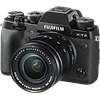Main
Model
Price
Advantages
launch
Announced
Body type
Camera subcategory
Sensor
Effective pixels
Max resolution
Sensor size
Sensor type
Processor
Image ratio w:h
Sensor photo detectors
Other resolutions
Image
ISO
Boosted ISO (minimum)
Boosted ISO (maximum)
White balance presets
Custom white balance
Image stabilization
Uncompressed format
JPEG quality levels
Photography features
Minimum shutter speed
Maximum shutter speed
Aperture priority
Shutter priority
Manual exposure mode
Subject / scene modes
Built-in flash
External flash
Flash modes
Continuous drive
Self-timer
Metering modes
Exposure compensation
AE Bracketing
WB Bracketing
Maximum shutter speed (electronic)
Screen / viewfinder
Articulated LCD
Screen size
Screen dots
Touch screen
Screen type
Live view
Viewfinder type
Viewfinder coverage
Viewfinder magnification
Viewfinder resolution
Videography features
File Format
Microphone
Speaker
Resolutions
Optics & Focus
Autofocus
Manual focus
Number of focus points
Lens mount
Focal length multiplier
Physical
Weight (inc. batteries)
Dimensions
Environmentally sealed
Battery
Battery details
Battery Life (CIPA)
Storage
Storage types
Connectivity
USB
USB charging
HDMI
Microphone port
Headphone port
Wireless
Wireless notes
Remote control
Other features
Orientation sensor
Timelapse recording
GPS
Samples
Videos
Summary
The Nikon D850 highest resolution of 8256 x 5504 pixels (46 megapixels) is better in comparison with the X-T2 highest resolution of 6000 x 4000 pixels (24 megapixels). The Nikon D850 is equipped with bigger sensor than the X-T2: Full frame (35.9 x 23.9 mm) versus APS-C (23.6 x 15.6 mm). This is very important advantage of this camera as big sensor allows you to make photos of the better quality. The Nikon D850 has a wider ISO range of 64-25600 in compare with 200-12800 ISO range of the X-T2. Such ISO numbers let the photographer to make better photos in low light conditions. The Nikon D850 offers more number of white balance presets - 14. This specification gives you more control over colour. The Nikon D850 can save files in RAW format which gives the camera owner a wider options for post processing. The X-T2 provides more focus points in compare with the Nikon D850: 325 vs 151. More number of focus points means more convenience while attempting to focus on objects that are not centred.
The Nikon D850 screen is better as it offers more screen dots 2,359,000 in compare to 1,040,000 dots of the X-T2 screen. The higher dot count screen is better for reviewing images on your camera. The Nikon D850 is produced with Yes inch touch screen that is bigger in comparison to No inch screen of the X-T2.
The D850 supports external flash. It provides amazing control over the exposure and lighting of the object in low light and in bright light conditions when you need to fill-flash. The Nikon D850 battery life is better than the X-T2 battery life. In accordance with CIPA standards the photographer will be able to make 1840 photos with the D850 and only 340 with the X-T2. The X-T2 weighs 507g which is 498g lighter in comparison with the weight of the D850.
Taking into account the above-mentioned differences the D850 will be the best buy. Check the list of the best offers on Amazon.


